Back to the NIKA2 run 1 main page
Contents
- November 2015, 10 (Tuesday)
- November 2015, 9
- November 2015, 8
- November 2015, 7
- November 2015, 6
- November 2015, 6
- November 2015, 5
- November, 2015, 4
- November, 2015, 3 (Tuesday)
- November 2015, 2
- November 2015, 1
- October/November 2015, 31-1
- October 2015, 30-31
- October 2015, 29-30
- October 2015, 28-29
- October 2015, 27-28
- October 2015, 26-27 (Tuesday)
- October 2015, 25
- October 2015, 24
- October 2015, 23
- October 2015, 22
- October 2015, 21
- October 2015, 20 (Tuesday)
- October 2015, 19
- October 2015, 18
- October 2015, 17
- October 2015, 16
- October 2015, 15
- October 2015, 14
- October 2015, 13 (Tuesday)
- October 2015, 12
- October 2015, 11
- October 2015, 10
- October 2015, 09
- October 2015, 08
- October 2015, 07
- October 2015, 06 (Tuesday)
- October 2015, 05
- October 2015, 04
- October 2015, 03
- October 2015, 02
- October 2015, 01
- September 2015, 30
- September 2015, 29 (Tuesday)
- September 2015, 24
November 2015, 10 (Tuesday)
- fX = fY = fZ = 0 is not a problem of TAPAS: last focus (scan 236) gave 0.0 correction for the 1mm arrays
- Opacities around 0.2-0.3 during the whole day. Atmosphere quite stable according to the taumeter but the kids see some short-timescale unstability.
- Mac12 rebooted spontaneously at 00:33UT
- Main goals today: obtain beam maps of Uranus to derive accurate geometry in good weather. Obtain polarization data to characterize polarization leakage and angle (on a quasar and on a planet at different elevations).
- Beam maps:
- several on Uranus. (Reminder Uranus fluxes 1mm= 43.7 2mm= 18.3) 20151109 scans 215 216 217 220 221 222 228 229 230- 20151110 scans 16 17 18
- also on Saturn (far side lobes characterization) 20151109 scans 173 174 175
- Total power OTF maps:
- Cluster CLJ1227 (30minutes).
- z = 6.3 galaxy HFLS3 (16 mJy at 1mm, 4 mJy at 2mm) : detected at 1mm

CX Tau (10 mJy at 1mm with PdBI) : detected at 1mm and 2mm !!!!


- pipeline development: OTF map of L1448 (filament with both faint extended emission and bright compact sources embedded)
- Polarization mode OTF maps:
- Polar otf on well-behaved quasar 3c286 (1 otf map at high elevation). Polar otf on Uranus (maps sampling different elevations)
November 2015, 9
- We used skydip 20151106s201 to compute C0 and C1. We recomputed the kidpar (kidpar_20151106_s211_213_215_skydip_v1) and measure the flux on Neptune and Uranus beam maps. For Neptune, we obtain fluxes around 31 and 14 Jy at 1 and 2 mm (we expect 17 and 7 Jy) and for Uranus, fluxes around 80 and 34 Jy at 1 and 2 mm, respectively (we expect 44 and 18 Jy). There seems to be a factor of 2.
- Opacities around 0.3 during the whole day. Atmosphere quite unstable though. A bit of wind.
- Main goals today: obtain faint sources / deep fields maps to estimate sensitivities. Obtain polarization data to characterize polarization leakage and angle.
- Beam maps: Uranus with Tau~0.25 (scans 253, 257, 258)
- OTF maps:
- Cluster CLJ1227 (only 30minutes today).
- NGC891: more integration to improve the data taken on 20151108: quite nice map as result (tau_225~02, 80 min), see below.
- Moderately faint z = 3.93 galaxy MM18423 : detected at both bands (SNR ~ 7-10 in 25min with tau_225~0.25, NIKA_1 fluxes=33.6 and 6.4 mJy). Images below.
- NGC891: more integration to improve the data taken on 20151108: quite nice map as result, see below.
- Moderately faint z = 3.93 galaxy MM18423 (30mJy at 1mm, 6mJy at 2mm): detected at both bands (SNR~7-10 in 25 min, tau_225=0.25).
- z = 6.3 galaxy HFLS3 (16 mJy at 1mm, 4 mJy at 2mm): tentative detection - to pursue.
- GF9-2 and L1157 as sources with some extended emission (60 and 500 mJy respectively): both detected, but extended emission still missing.
- CXTau: faint source (10 mJy T-Tauri disk) that was not detected with NIKA. We spent 180 minutes on source total before having tantalizing doubts about the non-detection, checking the literature (PdBI data by Pietu+ 2014) and realizing the coordinates of CX Tau in the pako catalog are wrong by 20'. The data taken before 20151109s25 are therefore a very good experience for an empty field: use that for sensitivity estimate ? Corrected coordinates in pako (now CXTauGood) and starting mapping again hoping for a detection. Indeed: first tentative detection at 1mm (tau_225~0.25, 100min), see below.
- GF9-2 and L1157 as sources with some extended emission (60 and 500 mJy respectively): both detected, but extended emission still missing.
- CXTau: faint source (10 mJy T-Tauri disk) that was not detected with NIKA. We spent 180 minutes on source total before having tantalizing doubts about the non-detection, checking the literature (PdBI data by Pietu+ 2014) and realizing the coordinates of CX Tau in the pako catalog are wrong by 20'. The data taken before 20151109s25 are therefore a very good experience for an empty field: use that for sensitivity estimate ? Corrected coordinates in pako (now CXTauGood) and starting mapping again hoping for a detection. Indeed: first tentative detection at 1mm, see below.
- Polarization mode OTF maps:
- Polar session on well-behaved quasar 3c286 (2 otf maps at different elevation).
OTF map of the Crab: 6 coverages --> should be quite good data.
- Polar session on well-behaved quasar 3c286 (2 otf maps at different elevation).
NGC891 (Tau_225~0.2, 80min):

CXTau (Tau_225~0.25, 100min):

MM18423 (slightly smoothed) (Tau_225~0.25, 25 min) :
November 2015, 8
Opacities around 0.5 during the day and down to 0.2
 in the night. Atmosphere quite unstable though. A lot of wind from 00:30 UT.
in the night. Atmosphere quite unstable though. A lot of wind from 00:30 UT. STOPPED AT 01:35 UT because of large telescope oscillations happening again.
 Happened at the begining of an OTF map (that was following a track as instructed): operator decided to stop operations for the night until problem is understood. (Wind was high again! Operators have received new instructions on what to do should telescope start oscillating again: cancel scan, change source for one scan, and then try continuing observations. Information is collected here. CK/JP 8-Nov 10:23)
Happened at the begining of an OTF map (that was following a track as instructed): operator decided to stop operations for the night until problem is understood. (Wind was high again! Operators have received new instructions on what to do should telescope start oscillating again: cancel scan, change source for one scan, and then try continuing observations. Information is collected here. CK/JP 8-Nov 10:23) - We have been running with 13 boards all day, geometry from beam map on Uranus obtained on 2015-11-07 was implemented.
- Beammaps for the 13 boards configuration: on Uranus (scans 251 253 255)
- Polarization mode OTF maps of Uranus (scan 248), 3c286 (scans 178 179) and Cyg A (scans 217-243)
- Total power OTF maps: CL1227, MM18423, FTTau, CXTau, ZZTau, NGC891, L1157. Some very nice detections, see map of NGC891 and FTTau below. Some very nice data to estimate NIKA2 sensitivities (see for example scans on CX Tau).
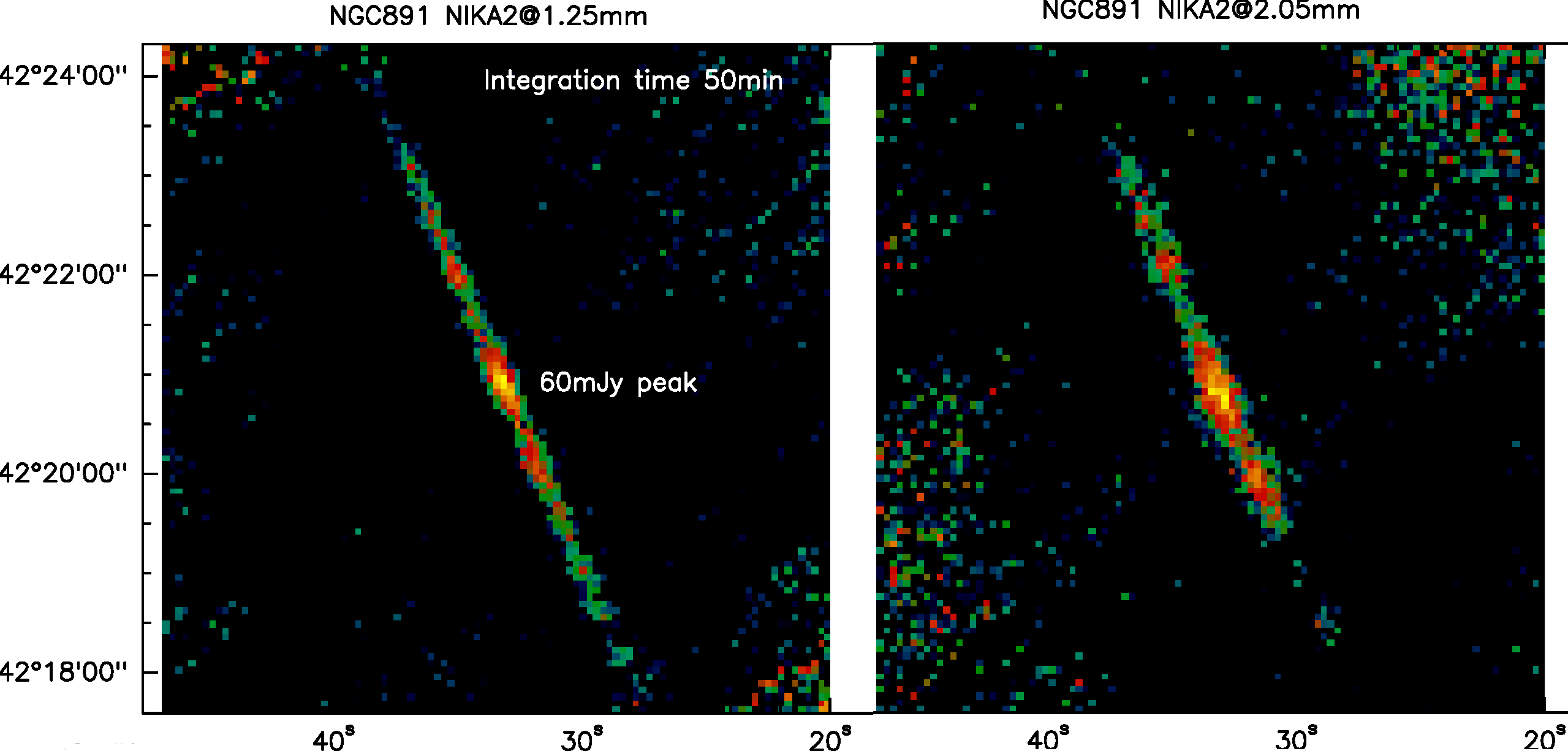
November 2015, 7
- Opacities around 0.7 during the day/evening - reduced to 0.5 after 1pm.
- We have been running with 13 boards since Alain fixed the software bug = happy observers.
- Beammaps for the 13 boards configuration:
on Saturn (not optimum but a first attempt): scans 157, 158 and 159 reduced by Juan : we implemented the new geometry from scan 211.
on Uranus later in the night with better atmosphere: scans 211 213 215 of 20151106 - do this first, reminder Uranus fluxes: 54.76 Jy at 1.25mm and 20.71 Jy at 2.05mm (right fluxes?) and scans 20 22 24 of 20151107
Polarization mode OTF map of Uranus:scan 209
OTF map of the Crab: 20151106 s223 s225 & 20151107 s2 s11 s27 s29

- Continuation of beamwidth monitoring with 3c84 using otf with smaller speed. Data must be re-reduced with improved geometry. Will report in "Beamwidth discussion" twiki afterwards
some scans not written: scans 14 of 20151107. Note that scan 13 is a large file for a pointing, and impossible to reduce. + scan 13 finished writing soon after scan 14 ended -> were scans 13 and 14 written in the same file ? Note that individual antenna imbfits do exist in t22 observationData/
November 2015, 6
Concerning the Azimuth oscillations seen last night, we see that before starting the 2nd beam map the telescope sometimes started oscillating very rapidly in Azimuth with 3arcmin peak-to-peak amplitude and 1sec period. Albrecht and I suggest to do a track scan before starting the 2nd and 3rd beam maps. Please report also directly to us in case the problem repeats. (AS/CK)
- Still very high opacities : 0.8-0.9 through whole day. Not quite sure anything super useful was done.
- Had some issues with the telescope crashing (motors alarms) at the beginning of some otf maps (actually second otf command of beammap.pako, see below). We tried to change the parameters of otf and ran them, and when we issued the same command that was precedently crashing the telescope it worked fine again - unclear what happened from observer's point of view.
- Had a file not written (scan 174). TAPAS missed scan 9 of 20151105.
- Tested the configuration with only 1mm arrays: did a geometry (scans 151 155 162 163 are good scans) and waiting for results.
- Then back to 11 boards configuration : Beammap on Uranus in total power: one seemed good (scans 164 165 166). One otf map of Uranus in polar mode (scan 76): could not reduce it in real time (see Tapas for error message). Continuation of beamwidth monitoring on 3C84, statistics will be reported on thread "Beamwidth discussion" later today.
November 2015, 6
Still very high opacities : 0.8-0.9 through whole day. Not quite sure anything super useful was done. Had some issues with the telescope crashing (motors alarms) at the beginning of some otf maps (actually second otf command of beammap.pako). We tried to change the parameters of otf and ran them, and when we issued the same command that was precedently crashing the telescope it worked fine again - unclear what happened from observer's point of view. Had a file not written (scan 174). TAPAS missed scan 9 of 20151105.
Tested the configuration with only 1mm arrays: did a geometry (scans 151 155 162 163 are good scans) and waiting for results.
Then back to 11 boards configuration. Beammap on Uranus in total power: one seemed good (scans 164 165 166). One otf map of Uranus in polar mode (scan 76): could not reduce it in real time (see Tapas for error message).
Continuation of beamwidth monitoring on 3C84, statistics will reported on thread Beamwidth discussion later today.
November 2015, 5
- Telescope not behaving well during otf scans over some time. See scan 152 18:53:19 and 156 19:26:04. Azimuth currents suddenly strongly oscillating (cf. operator report of 6-Nov 6:05 and comments in TAPAS). Nothing unusual about the OTF script.
- testing polarimetry
- 11 board configuration
- Telescope not behaving well during otf scans. See scan 158 and before.
There is a rising number of problems with the data synchronization: In addition to the gaps in antenna traces the gaps in the subreflector traces are getting larger and are more frequent - especially since yesterday night. The attached figure srTdiff.png shows the time increment in subreflector traces since midnight Nov 4. The largest gaps are ~1min, but in order to show the trend of this problem I set the limit to 0.5sec. Furthermore, since yesterday, scan ~20151104s155, we observe not just gaps in the subreflector traces but also a kind of delay, i.e. the time increment is not ~0.25sec but increases to <2 times this value (reported by RZ):
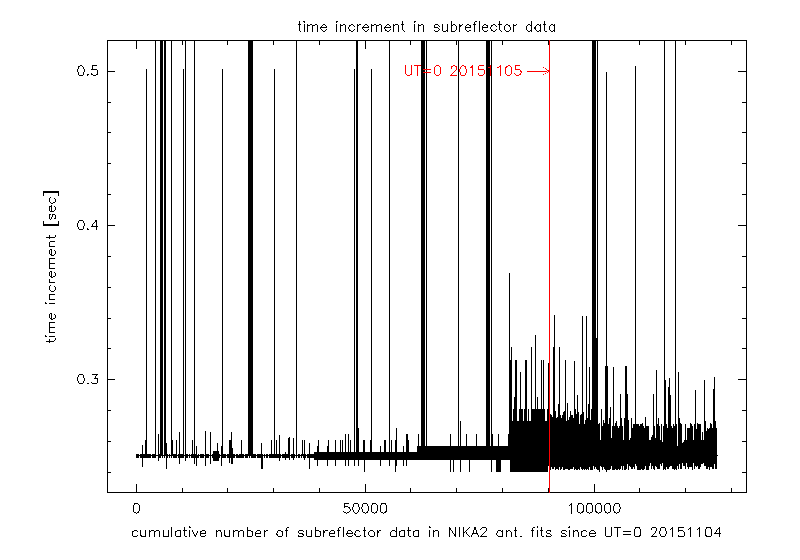
- TAPAS missed scan 10
November, 2015, 4
- Bad weather, opacity between 0.5-0.8.
- Spending almost the whole day to fight with the acquisition software trying to make the 13 boards configuration working. We do not understand the origin of the problem yet. We tried a beam map, but we got bad quality results. We decided therefore to switch to the 11 boards configuration to have first light in polarisation. Got it!
- Configuration of polarisation measurements: F_mod=46.68 Hz, mechanical rot. freq. = 3.9 Hz, 12 data per tour.
- TAPAS misses some pX,pY pointing offsets (e.g. Scans 118 - 149)
New pointing constants fitted by JP, and implemented for first Scan of the day, #118. See here.
November, 2015, 3 (Tuesday)
- We came back to the configuration with 11 boards, It works. After that, Alain changed the tuning procedure. We implemented the modifications. It works better.
- Problems with acquisition: observing with 13 boards together, the lecture software generates files mixing data between feedlines, impossible to reduce!
- We started the observation at 5pm with the new configuration.
- Configuration file with 13 boards done. It works!
- 2 new electronic boards installed on array 3, feedlines 13 and 19. Resonances found and saved in an intermediate configuration file (nika_1mm_v3.ini).
- High wind, some snow, and heavy clouds...
- NIKA2 team change over day: H. Roussel, A. Ritacco, FX Désert go down, F. Ruppin stays, A. Maury, G. Coiffard and A. Catalano arrive.
- Waiting for photons:
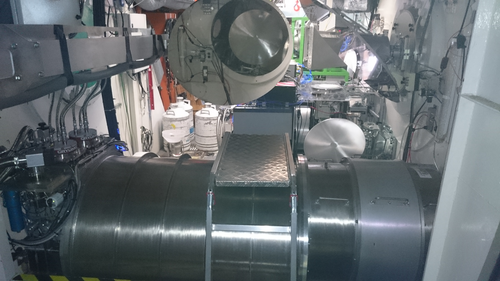
- Gaps in antenna traces are reported by RZ. See example below; it happened during the map 20151101s30, i.e. Horsehead:
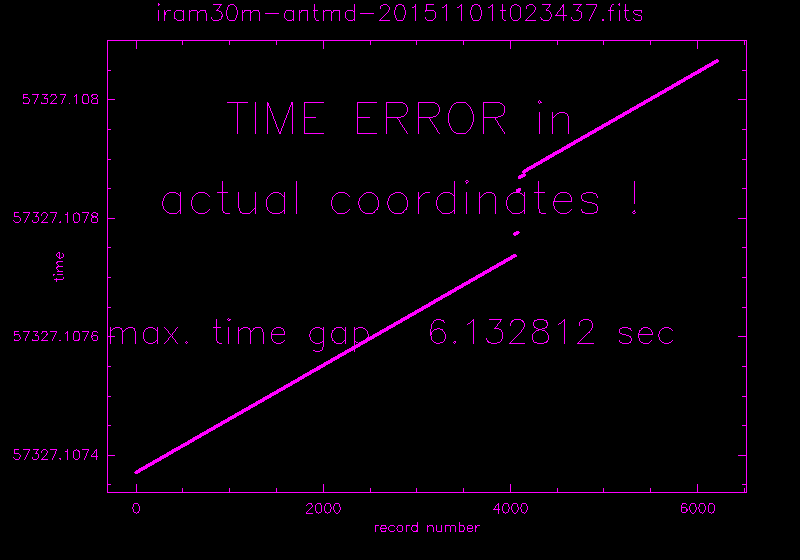
November 2015, 2
- Weather clears up after the storm at 5
- Trying to observe with 11 electronic boards -- needed debugging and huge help from Grenoble... Very encouraging simultaneous use of the full 2mm array (4/4), one 5/8 array at 1mm and the other one 2/8. The pointing of the telescope was very brave in the wind that blew the mountain. That shows in the real pointing timelines (Fig to follow).
- At 18h30 we can start observing with some improvements in the tuning. Few pointing scans done on Uranus before the wind forces us to stop.
- It seems that ghost structures show-up independent of scanning directions, as reported by FR.
November 2015, 1
- Still stopped because of high wind
Beam patterns on Mars, Uranus, and 3C84 with Arrays #1 and #2 show the quadrupod/spider support structure at about -30dB, as expected from the NIKA-1 maps. See the discussion here. Deep maps on Saturn or Jupiter are yet missing from the data processing.
- Alain prepared the acquisition software for three arrays and 11 boards: Array #1 with 2 boards, Array #2 with 4 boards, Array #3 with 5 boards! To be tried once the wind slows down. Two more boards should soon arrive, which would allow to readout completely one of the 1mm arrays (with 8 boards).
October/November 2015, 31-1
- Trying to change to 2nd configuration (Both 1mm arrays: Array #1 with 2 boards, Array #3 with 5 boards) with help by Alain. Difficulties to tune array #3. Given up.
- Changing back to 1st configuration (Arrays #1, #2). Still only 2 boards connected to 1mm.
- Plan: DR21, Horsehead, NGC7538, CRL2688, NGC7027, MWC349, K3-50A
- Here the image of DR21OH obtained after 4 scans and a total time of 12 minutes (each scan rotated by 45deg), the array 1 on left and the array 2 on right.
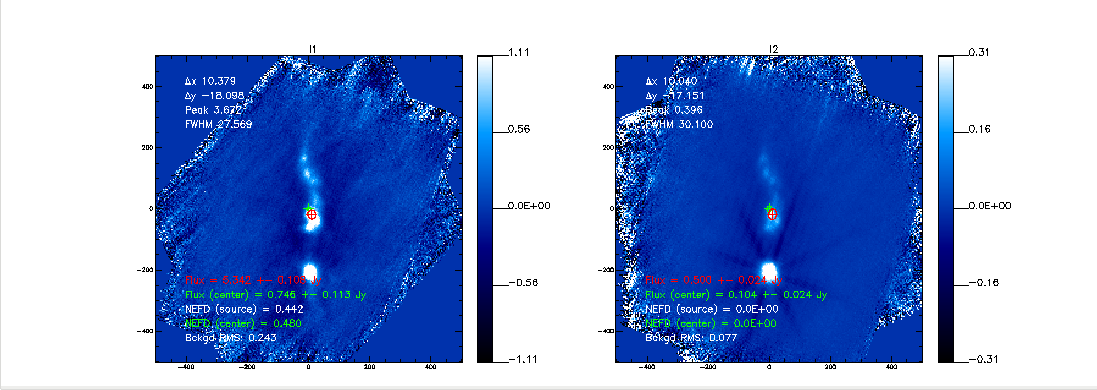
- Stopped because of very high wind ! :-((
October 2015, 30-31
- Continuing with the current configuration (Arrays #1, #2)
- Program for this session: Uranus beam, Secondary calibrators, Large map test on DR21OH, Map faint extended sources: CasA, NGC891, Noise integration on HLS091828, Mars beam, and with focus y+-1, IRC10216, 1h test map on CL1226 and skydips interspersed.
Opacities: For some skydips NIKA-1mm agrees with tau225 value ~ 0.6 and stable. However, in general the taumeter shows much more scatter than NIKA-2. See the study of of opacity by FXD.
- ELVIN crash. Recovered following the written documentation of Martino. It worked!
- General comments:
- Status at 2mm: 4 old boards for full array. Open issues:
- after first beammaps, kidpar only uses 525 pixels out of 1020 (50%),
- Pending: fit and implemention of new pointing model
- We wait for end-of-scan of NCS, wait for taking data (double-beep), and then start the next pako/observing script and, at the same time, the IDL-script to merge and reduce data. Otherwise, pako would confuse data acquisition. Try to optimize dead times in the future. Also, subscan-wise reduction would obviously be nicer.
- Status at 2mm: 4 old boards for full array. Open issues:
Here are some early but spectacular results for extended sources CasA, NGC891, and a test on the detection of a faint point-source at z=5.4
October 2015, 29-30
- Back to the first configuration, with Array #1 (1mm) connected to 2 old NIKA-1 boards and Array #2 (2mm) connected to 4 old NIKA-1 boards, reading out all pixels of the 2mm array.
We did pointing, focus in x,y,z, a beammap, and then a pointing session (Lissajous and tracked). The sky is clear, 225GHz-opacity is stable at 0.7, slowly improving to 0.5.
Focus values stayed at almost 0, 0, 0. Observing modes Track and Lissajous work fine. Though Lissajous is slower it delivers far more accurate results. Best FWHMs at 1mm are ~11".
Pointing offsets observed during the pointing session stayed within +/-5"; the rms is only 2.0"/2.6" in Az/El. The corrections follow an arc and span >11" on sky (RZ, Oct 30).
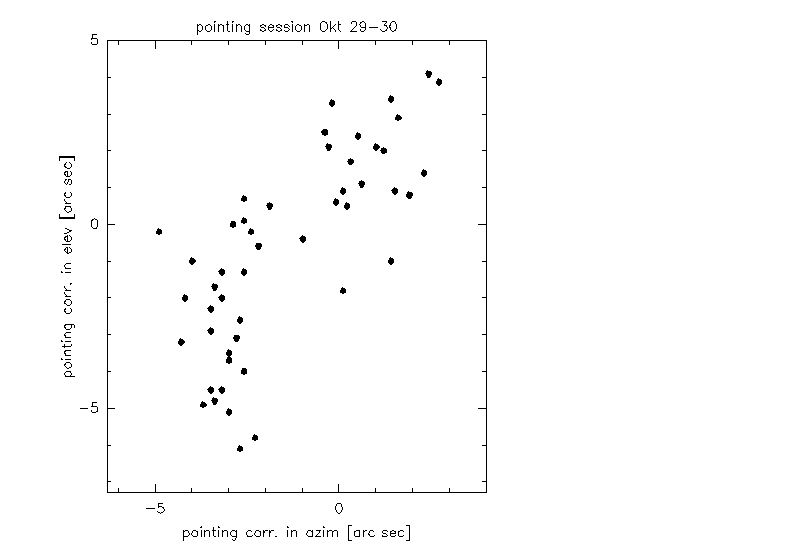
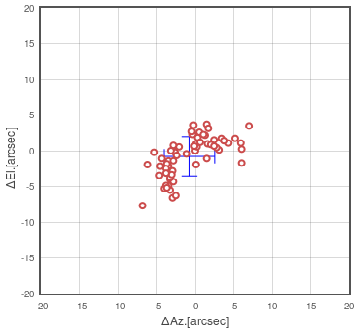
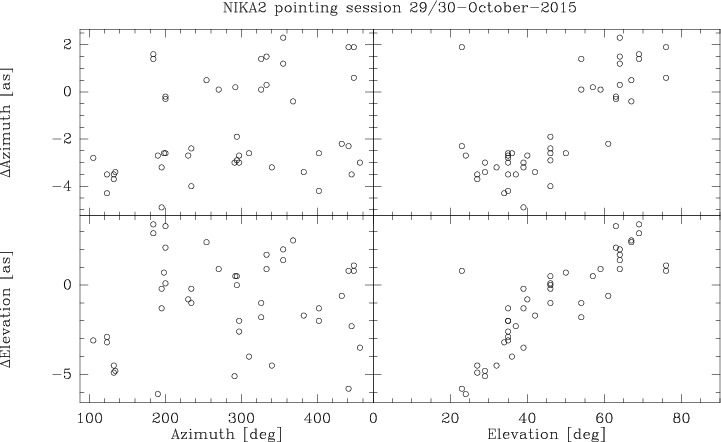
Left: pointing corrections during the pointing session. Center: pointing corrections Okt 29 and 30 till scan #71 (from TAPAS). Right: Pointing corrections vs. Azimuth and Elevation.
- Beammaps done with different z-focus values: -0.1, 0.4, 0.9. (Focussing on the central part of the arrays may not lead to the best overall focus for all pixels.)
- Beammaps done with different x-focus values: -0.7, 0.3, 1.3.
- Several skydips done. Scan 61: tau225=0.59, 1mm=0.62, 2mm=0.37, Ratio=1.7
- Comparing Lissajous maps with on-the-fly maps in perpendicular directions on Arp220, which is visible in both arrays in individual otf scans ! Lissajous maps show a stronger noise level after de-correlation !
- 1 square-degree map on rhoOph in Azimuth direction (under meager conditions: tau225~0.8 and fluctuating, 25deg elevation)
- General comments:
- The taumeter 225GHz opacities showed a large scatter till about 29-Oct 20UT, larger than what we observed with NIKA or EMIR. The correlation between NIKA and tau225 is poor for 29/30-Oct.
- nkpoint b often shows good Gaussian fits in Az/El, but suggests wrong pointing offsets.
See TAPAS for comments on the scans. TAPAS now also displays lateral focus offsets (thanks to Pablo).
- We do a track scan upfront of each observations, to allow for tuning. Some procedures contain in addition a tune subscan.
Wiki with list of targets brushed up.
- It is right now not possible to digest more than about 6 boards by the software. That'll be discussed with Alain.
- Tracking errors are taken into account in the data pipeline. (FXD)
Reminder: tracking errors are invalid for the first up to 2 sec (i.e. even >2 arcmin) in each subscan; 3 latest examples are shown below (RZ, Oct 30).
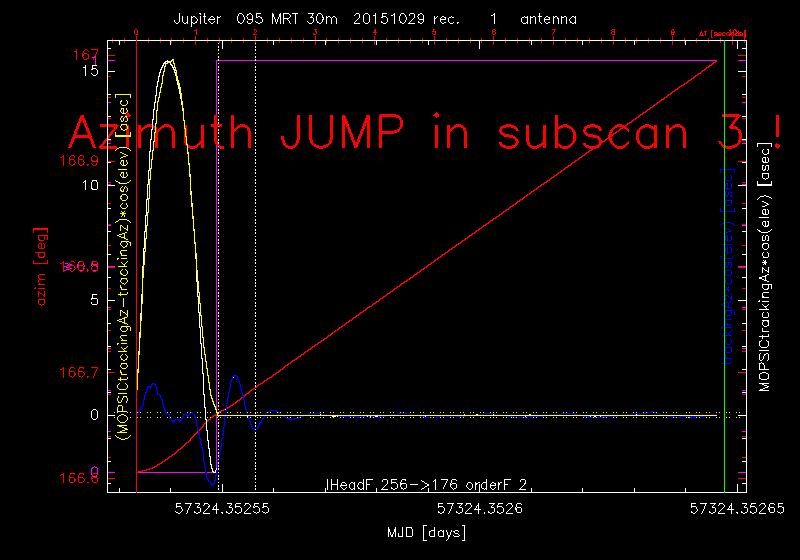
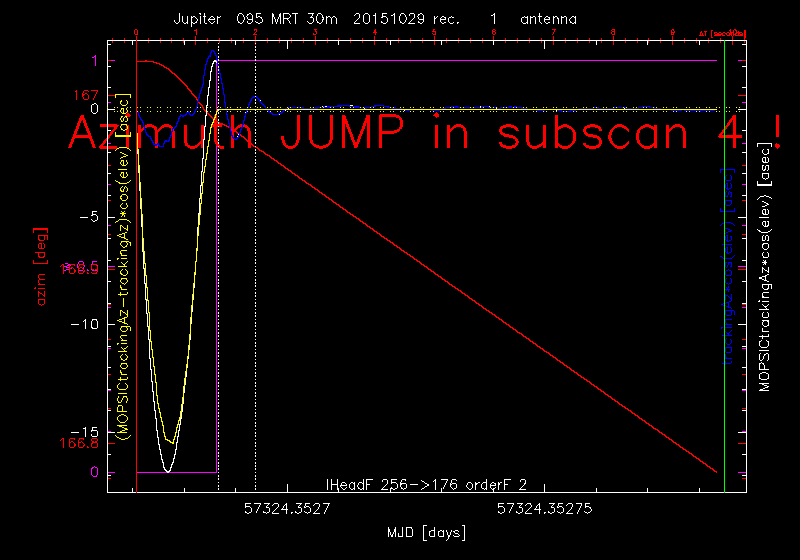
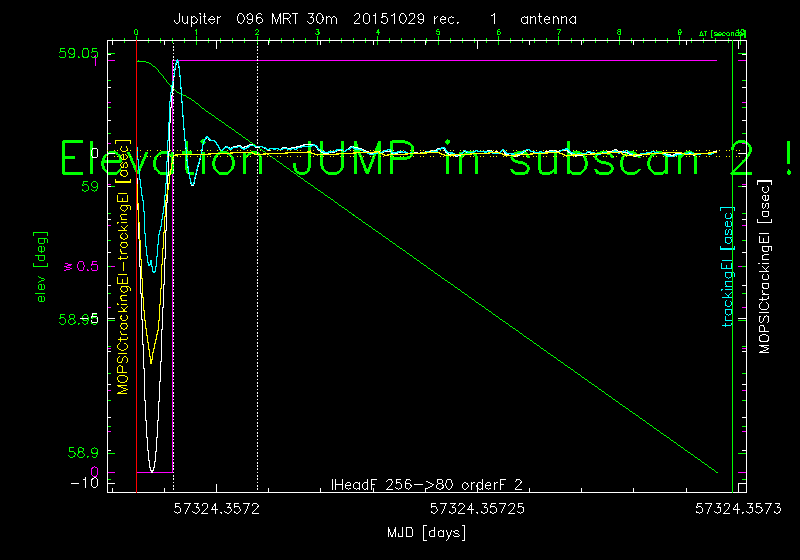
The available tracking errors are shown in blue (for azimuth) and cyan (for elevation), the correct ones in white
October 2015, 28-29
We start the observation with the two 1mm arrays.
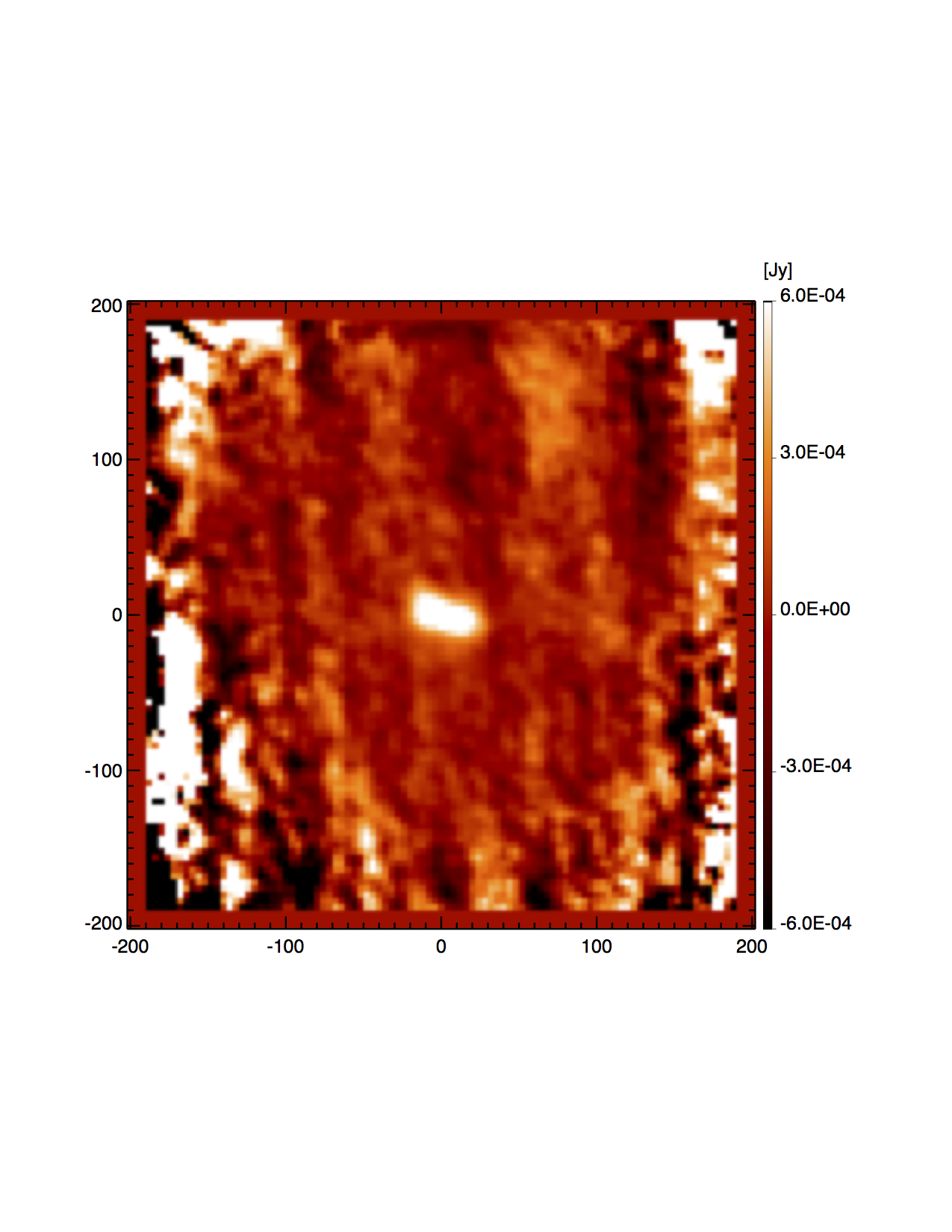
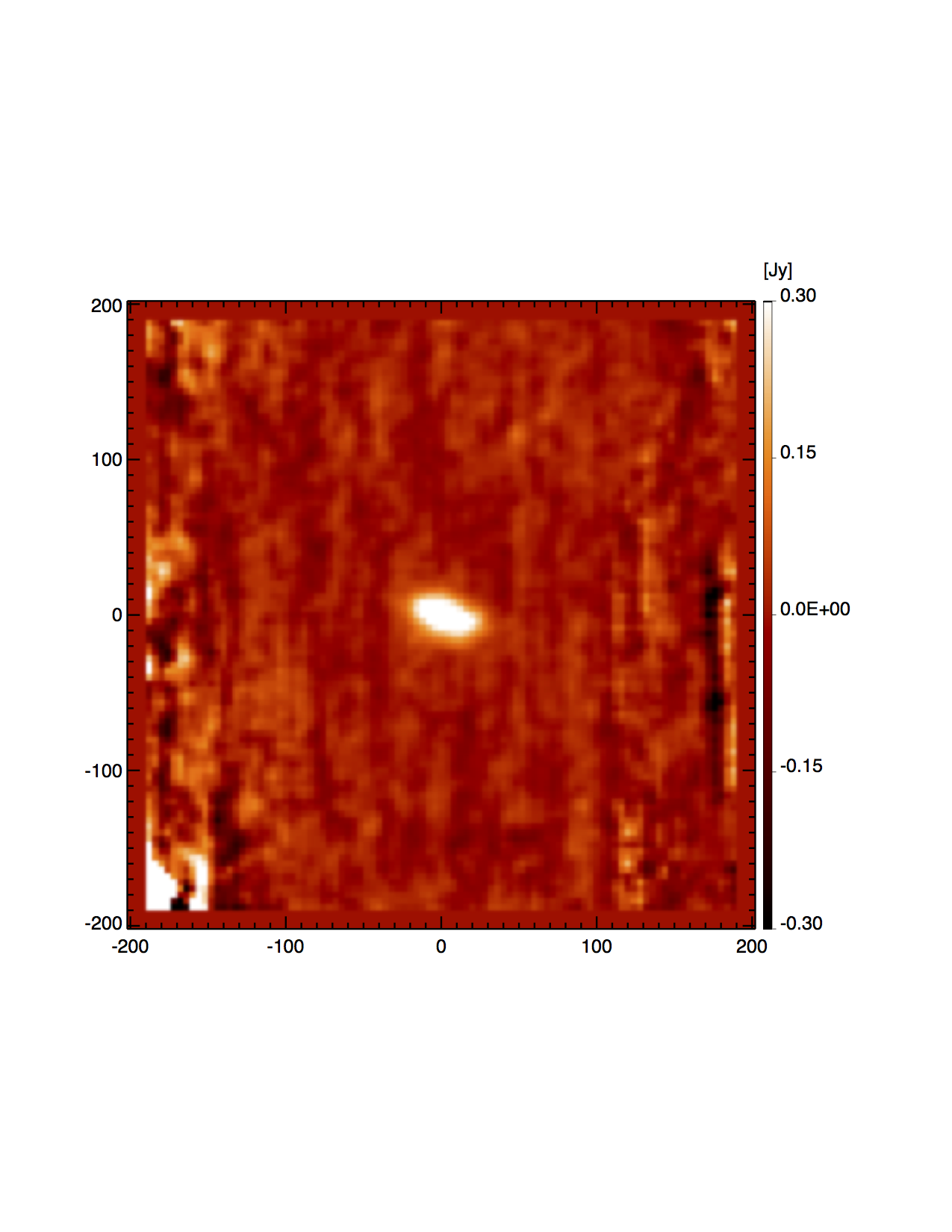
Figure. M82 maps, array 1 on left and array 3 on right
October 2015, 27-28
We started the observations at about 10:30 pm with the configuration array 1 and 3. We did some beam map and then we have switched to the initial configuration using the 2mm and one array 1mm. During the night the weather becomes good and we observed bright and faint sources. This morning we want to observe some faint galaxy and extended source. 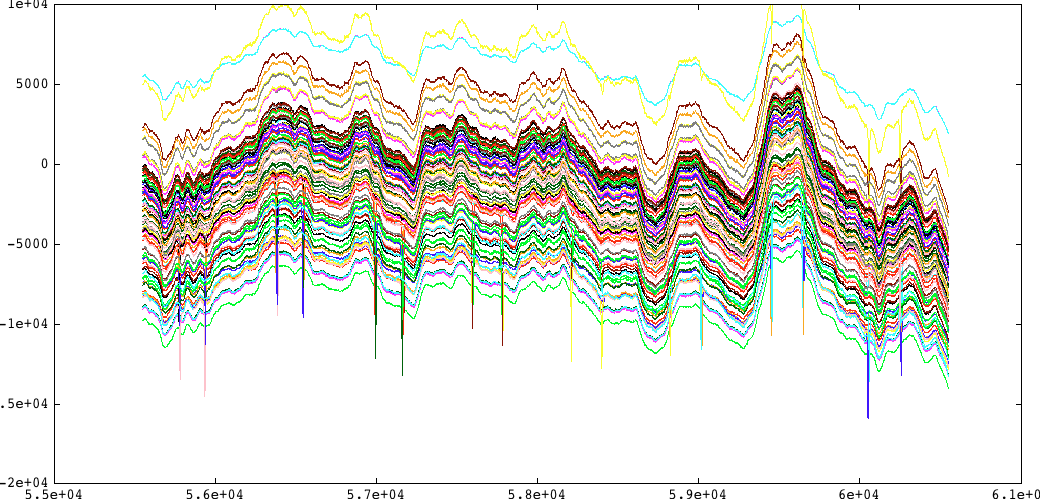
Figure. Time ordered data during beam map on Uranus with the configuration using the array 1 and 3
October 2015, 26-27 (Tuesday)
We built a new configuration to have the AMC cards working with only array 1 and 3. We tried it twice but we did not manage to recover the resonances at all. We switch back to the old configuration that works with no problems at all. The observing night was pretty good with opacity down to 0.3 and below 0.5 We still have problems with nk_focus_liss that gives wrong results (software bug found and corrected, data are correct).
October 2015, 25
Mainly bad weather
October 2015, 24
We observed untill 14h30. After this the weather degraded significantly with some showers and a bit of snow.
October 2015, 23
Good observation day.
October 2015, 22
After cooling down the cryostat during the night (due to a problem in the late afternoon of yesterday), we started observing at 9h UTC, not too bad weather (tau 0.3). We started the today session comparing the different focus strategies. We noted that the focustrack is more reproducible than focusliss along the 3 axis. Moreover the error bars in focusliss are worse - not normal as integ. time per subscan in focustrack is less then integ. time per source in focusliss RZ. Thus, for the rest of the session we used the outputs of focustrack. At 10:50 UTC we started the geometry session computing a beammap.
October 2015, 21
Night shift with bad weather. Coud not focus on Uranus (could not reduce foculiss and the new focus track takes only 3 points -focus track has always taken 3 points, more points is useless and would take more time, if necessary increase the distance between the points SL-- and/or increase the number of subscans (in modulo(3) of course !) RZ-). Did checks of all observing map modes on Jupiter + Gnanymede that should allow us to see if the maps are correctly oriented). In the morning we had 4 hours of relative good weather. We have tested observations in a Mars' moon, Phobos, and NCS is working thanks to Albrecht.
October 2015, 20 (Tuesday)
Samuel L. left, Juan M. and Laurence P. arrived.
Very bad weather conditions. Nothing done.
October 2015, 19
Nicolas and Juan S leaved, Andrea B arrived.
Still clouds, winds and rain, so no observation today.
- NIKA2 detectors stage reached back the base temperature around 11 this morning.
- Detailed plan of the instrument characterization updated on the private wiki, with the inclusion of the current status.
October 2015, 18
Wind and rain all day.
- Nico worked on automatic pipeline reduction at end of scan and automatic logbook generation after each processing. It's all working except skydip processing.
- Martino (with Alessandro on Skype) fixed the problem of the dilution fridge injection line increasing pressure we had for several days, which would have caused to stop the fridge working in about a week from now. This operation implies that we can't use the cryostat for ~ 2 days, given the weather forecast we take the chance to do it now. He recovered the 3He from the system to the tank, the time to isolate the internal trap that was blocking little by little the injection probably due to a small leak in one of the pipes, in order to install a bypass with an external charcoal trap dipped in a nitrogen bucket. Then he re-injected the 3He in the circulation unit. After few hours the 3He-4He mixture was circulating again, and the cryostat was cooling down again after a rise from 100mK up to 12K of the mixing chamber.
- Samuel worked on reviewing, cleaning, updating, testing (with set dosubmit no) all the PaKo scripts useful for the run (and probably for any future run).
- Hervé worked on the calibration parameters from Mars, Uranus, Neptune, and on the effect of atmosphere (ATM model 2009) on the NIKA2 band pass.
October 2015, 17
9h-18h:
- Resume focus try. Sky too bad for X Y.
- Beam map on Mars, we miss one with the new pointing model parameter (Nasmyth offset implemented yesterday), but given the sky we don't believe we can get a good one; at least we can stack stats on the pixels stability.
- Same kind of idea with the test of sensitivity mapping the 50 mJy HLS091828 source.
- Retry beam map on Mars, not only for stat, but also because we saw a jump on the time traces of the 1st beam map, making it unusable to derive parameters.
- Take the opportunity of the conjunction of Mars with Jupiter, to try mapping Jupiter with its satellite, not only for the picture but also to test nkotf PaKo script, various scan directions, and map reconstruction with an object which has an orientation (i.e. not circular symmetric).
- Sky dips.
- Lost 1 hour due to Wind (and clouds).
- Lost 1.5 more hour due to 2 unfortunate errors: (1) Each time we restart PaKo we have desynchronized scans, or the NIKA Acqui control software crashes, need to restart control software and re-sweep the resonances; (2) NCS crashed several times in a row, Israel and Juan Luis realized it's because we choose Ganymede for our source to map Jupiter's satellites, we eventually figured out that NCS CAN'T TRACK PLANET'S SATELLITES.
- Since Jupiter got too low for the oriented source structure mapping tests, we found some replacement candidates; found Cyg A and DR21_OH, which are close to each other and close to secondary calibrator MWC349. After difficult calibration on MWC349 due to bad weather, we decided it didn't worth doing integration maps on it, and focused on the orientation maps, which only require to see the source to test the scripts and the map reconstruction (weather too bad for other tests we could do with such sources). DR21_OH appeared on both 1mm and 2mm bands, Cyg A only very bright at 2mm but invisible at 1mm; so test maps on DR21_OH; unfortunately rain and wind didn't allowed us to test the RaDec scans. Got to stop the telescope.
20h: Wind lowered, tried to resume the RaDec scans tests, we got just the time to point MWC349 before the wind rised again and forced us to stop the session for today.
October 2015, 16
Charles arrived.
9-21h:
- We resumed our tries to optimize the focus in X Y and Z. We discovered a bug in the PaKo script we used for the lateral focus: we were in fact doing only Z focus... we did tries by and changing X and Y focus and doing cross scans; appearance of side lobes consistent with optics simulation. We still got a residual side lobe, but observing strategy with reduction tool available not sophisticated enough to conclude. HU answered quickly to fix the error in the PaKo script, but the weather and elevation of Mars got too low to continue investigating X Y focus, so we went back to the best but apparently not optimal (small asymmetric side lobe at 1mm) position found by hand: (0,0).
- We took the chance of a sky still decent, to make the mini pointing session that would allow us to derive a 1st Nasmyth correction to put the optical axis close to the reference pixel we have chosen (pix 830 on 2mm array). We had the time to do it, contacted Juan P, who could derive the correct parameter and implement it in the NCS pointing model. We checked it on few more pointing at various elevation and witness much smaller pointing offsets with much less variability in elevation. So now we have a good starting point for the real pointing session to make once we have the optimal beam map and focus, and thus kidpar, and, a good sky to do it.
- Few skydips, beam maps, focus. - Too finish the session: a OTF map on IRC-10420, with 100-400 mJy expected at 1mm; a source not too strong not too faint to have a first quick idea of the sensitivity.
October 2015, 15
9-21h. Iterate pointing, focus, beam maps on Mars. Try 3 different methods for the focus (lissajous, track, crosses) to check consistency of data reduction. Indication of a small coma on beam's side lobes, try X & Y focus. Unfortunately sky noise increased, clouds arrived and Mars got too low before we could conclude on the XY focus. No planet available past 16h local time, except Saturn which is too big. Try some bright point sources, Saturn (see if with a beam map we can catch Titan + Saturn), and secondary calibrator. The clouds disappeared then stayed below the telescope at the end of the day. 2 lines of KIDs nearly disappeared but were recovered. Though maps looks promising, we still don't have the optimal focus + beam map combination. Sometimes 2 scans are merged in one NIKA file; we don't know why...
October 2015, 14
9-14h. Iterate numerous pointing, focus, beam maps on Mars. Atmosphere not great (some clouds, tau...), so it's a bit difficult to get good beam maps and foci that allow deriving proper parameters and observational settings.
October 2015, 13 (Tuesday)
Samuel, Hervé, Juan S arrived.
SL, JP, NP decided the strategy/procedure to adopt for the pointing session that will be done once pointing / focus / beam maps iterations have converged to stable parameters (see run preparation page updated on private NIKA2 wiki).
22-3h. Pointing and focus. Try 1st iteration on focus X and Y. Pretty good FWHM of 13 & 18" @ 1 & 2 mm, given the relatively poor weather condition. TAPAS was not working with NIKA2, IH and FD, found a patch. Even if the sky is not too great, we decide it worth doing a beam map at least so see again the response of all pixels and test the processing routines. Result give 17 and 19" ... hum, sky. As long as we don't have good enough iterations on focus and beam maps, we are a bit stuck on iterating again.
October 2015, 12
Alessandro and Andrea left.
Few scans, pointing, focus, 1st beam map to check all detectors reponses.
October 2015, 11
Rain, nothing to do the whole day. Working on planB ....
October 2015, 10
Nicolas produced the first map approaching something reasonable (still non calibrated, still not focused !). To do that he has used the geometries made on the 7th of October during the hour or so that was decently usable. The beams of NIKA2 are well separated, we have arrays ! The beam maps looks like the ones we produces in lab, and they are consistent with the arrays design (of course).
Figure. Mars map at 2mm (900/1000 pixels) and 1mm (210/240 pixels). Not focused (as you see), not calibrated, from the OTF scan (400x220") 112 on the 7th October (the only decent spot we had so far).
14-17h plan. Focus on focus in order to see if we can launch a decent geometry.
October 2015, 09
In the morning the two Nicolas arrived to stay. We also had the visit from Alicia and Patricia from CAB-INTA Madrid.
The reference resonance on VNA (1959MHz, feed 11) shifted to the right by another 20 kHz.
13h. The sky is now cloudy. We turned anyway the mirrors and go on Mars to see. When opening to THIS sky I see the resonance shifting by 500kHz!! Compared to 250kHz last time in a sky that was already not so good. So we're currently looking at a T of the order of 150K, say.
14-17h. We observe in very extreme sky conditions. Difficult to understand anything.
October 2015, 08
In the morning trip to the Laguna and then Pico Veleta. We start observing earlier at around 13h30. Fixed a cable problem on the NIKEL 222 (B). In the afternoon cannot observe due to the weather, we try to work on the NIKEL_DC.
Our reference VNA resonance shifted by another 40kHz and gained almost 1dB in depth compared to yesterday. It means that the detectors are still cooling down slowly. That's good too. We're now at around 160mK on the cold plate and 175mK on the thermometer close to the 2mm array. When we open the window on the cryostat we see it clearly also on the mixing chamber temperature. Around 3mK on the thermometer close to the array, 0.7mK on the plate.
The afternoon we cannot observe due to the weather. We worked on the NIKEL_DC. It is working now. The noise seems at a first look pretty comparable to the other lines connected on the NIKEL_USB. But we have t work more on that during the following days.
Cryostat side: it is very well now. The injection pressure (key parameter) still going down, now lower than 1200mbar, all the temperatures too are slowly going down. We are still turning with the turbo at 40% of its speed. We could increase and gain in base temperature but we estimate that the most important thing now is to ensure stability.
October 2015, 07
1am: we have seen Uranus !! The priority is still Alain fixing the software. However we managed to go on Uranus and launch an OTF. The signal on one pixel seeing the source (difficult to find among so many pixels by eye) is around 1 kHz, for a noise plateau of the order of 1. 5Hz. The S/N is already approaching 1000, that's not bad before making any focus or any other thing. Uranus is around 16 Jy at 2mm. So the sensitivity figure is in the right range. But for now it's only the range. The focus (arbitrary) chosen by Israel is -2mm. In these conditions (elevation 54deg, tau still around 0.3) our reference resonance (feedline 11) is 250kHz down the "window on cryo" conditions. And 100 kHz above the elevation 33 deg. These numbers should already tell us a lot.
On the noise side there's no trace so far of the pulse-tube line. That's good already.
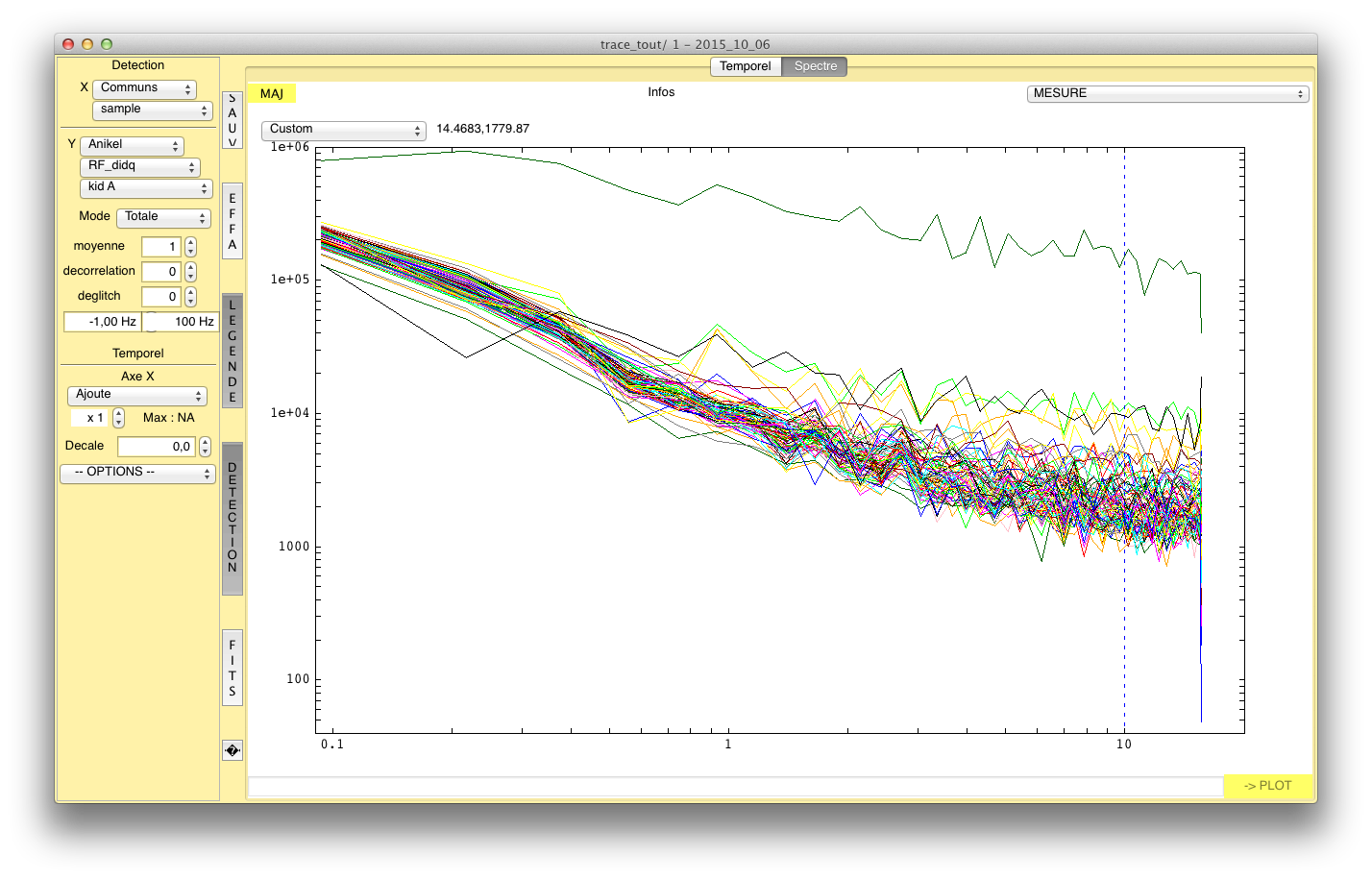
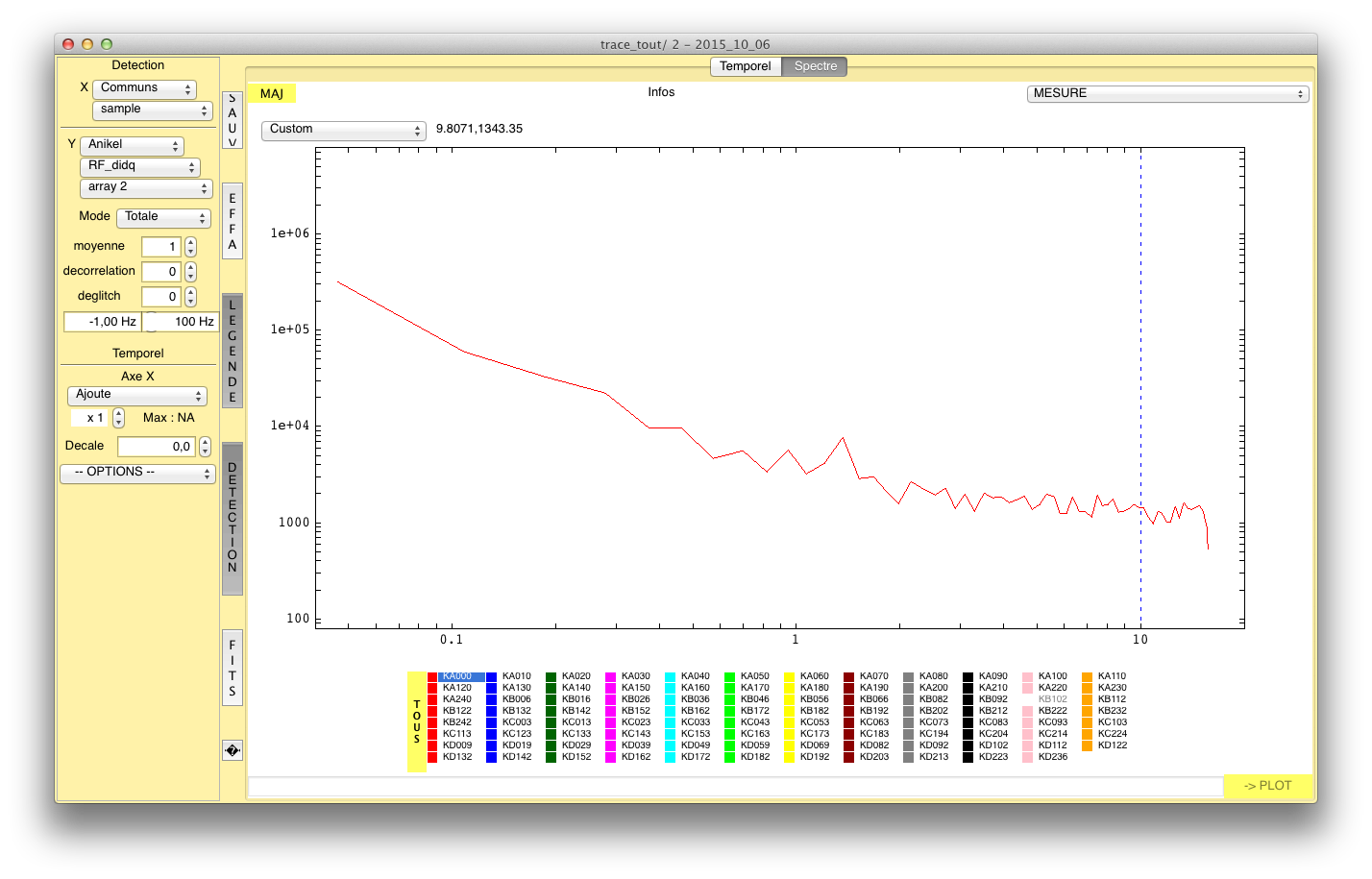
Figure. From left to right: Uranus transit on one pixel, 2mm array noise (random pixels) on bad sky, 2mm noise on a good pixel on better but not extraordinary sky.
4am. Going to bed, leaving the telescope to EMIR pool.
8am. Wake up, Alain leaving.
9am. The pressure on the compressors still the same it seems. The cryostat calmed down after an agitated night. Still cooling slowly. Inj pressure 1.5bars, T_base=175mK now. Our reference VNA resonance is a bit deeper and shifted to the right a bit (30kHz), means also the detectors are still slowly relaxing to base temperature. The tuning seemed to work overnight.
Observation slot 14-17h. We tried many different ways, but unfortunately the tuning is not working. So we have prepared the 2mm and two lines of one 1mm array (1mmH, IN/OUT 8 and 9) by hand. We then acquired three distinct geometries on Mars. The signal on the 2mm is of the order of 3kHz, on the 1mm up to 10KHz, but the big unknown is the tau. The taumeter says 0.25-0.3 but everything is jumping by 5-6 times more than Mars. Good news, it seems really that the pixels on the 1mm are very uniform. The noise in dark on the 1mm can in effect be as low as 2Hz/sqrt(Hz). We expect that on an excellent sky we could approach this. VERY IMPORTANT: even on the 1mm time-traces we do not see at all the pulse-tube effect.
October 2015, 06 (Tuesday)
Condensation launched during the night at 5h. At 2h30 reduced the flux to get close to 6K (stop preref).
NIKA2-laser aligned this morning, beam perfeclt on the center of M6, M5, M4, M3 and the polistirolo vertex. Good parameters are: Tilt is -1.7, Level = 10, l_ecart=0.5, l_time=2.5
At 12h the condensation is almost done, we plan to check the feedlines before lunch.
13h: ALL 20 FEEDLINES CONNECTED !!! Hopes are now justified. Expecting resonances in 4-5 hours.
19h: Alain working hard on the DAQ. Resonances are there. We see light. In the cabin we see people crossing or our hand in front of the window, so photons reach the detectors. Could be considered NIKA2 first light at Pico Veleta. The resonances on the 1mm array move for example by more than 500kHz from 0K (window on cryostat) to 300K (cabin). As expected/ We have verified that the noise is pretty OK on the 2mm. We are deciding a first light configuration based on software and available electronics boxes. The cryostat is cooling down quite slowly. Still at 185mK. Long time constants, we are after all at less than 5 days from the start of cooldown. A big result is that we are only one week after the arrival of our truck at the telescope and already measuring something. One potential issue is the jumps (delta f around 1kHz) we have seen during a very long/fast telescope slew in elevation. And smaller but periodics jumps (delta f around 100Hz) during a long slew in azimuth. Don't panic yet, to be investigated.
One resonance (1959 MHz) on one 1mm array (feedline 11) moves (to the left) by 900kHz from window on cryostat (say 0K) to open to the cabin (say 300K). On an average-bad sky (tau around 0.3) and at elevation 33deg the same resonance is 350KHz left of the "0K" (window on cryostat) situation.
October 2015, 05
The pulse tube compressors were still too warm this morning. When we looked at the problem with Juan P, Santiago, Dave, we realized the flow in the water cooling system was too low (<5 l/min); it turned out the problem was due to a dirty filter in the water circuit. Removing it solved the problem: the water flow increased to >15 l/min, and the compressors temperature decreased down to the specification zone.
We have resumed the alignment work. The distance between the M6 mirror and the cryostat was 4cm too long; we moved the cryostat in order to reach the required value of 1060 mm (with 20 mm more or less the pupils gets too much distorted). We also tilted the cryostat so that its laser follow a path very close and parallel to the M3 bearing laser.
Alain found a manual trick to have the polariser wheel rotating correctly. Time was also spent on the instrument software, and on the electronics with Olivier on Skype.
T0+96h. T_mixing_chamber=30K; T_still=16K; T_4K_plate=16K (foreseen start condensation at 3am during the night).
October 2015, 04
The cryostat continues to cool down gently. Extrapolating the curves, we should reach the base temperature by Tuesday afternoon. The pulse tubes compressors are suffering a bit, to reduce their internal temperature we ran both ventilators of the Marin cooling system at full speed. This helped, but we are still a bit high with respect to the temperatures specifications of the compressors. We saw that the Marin system uses a 2m3/h pump; it has also a 5m3/h pump, but not in use; let see with our colleagues from Granada if it would be possible to use this pump for the next time in order to increase the flux, and hence the cooling power of the Marin system.
Alain worked on the NIKA2 instrument software, which was not working fine with the current instrumental setup. We have also put in place the polariser wheel, adjusted its position and tested its control from the control room.
T0+72h. T_mixing_chamber=110K; T_still=46K; T_4K_plate=34K (leaving for the night with the heater on the 4K ON).
October 2015, 03
Today we have installed and labeled all the remaining cables between the cryostat and the electronics shelve through the pipe on the roof. It took almost the full day: probably the most cumbersome task of the week ! At the end of the day we have installed the electronics, plugged the cables, and start running the electronics.
T0+48h. T_mixing_chamber=202K; T_still=104K. T_4K_plate=60K (in the last cooldown in lab it was 190K, 99K and 45K respectively). For some hours we ran with a single compressor; moreover, we have the two MPPSYNC that are not well synchronised over long periods (hours).
October 2015, 02
This morning Johannes and Martino left to drive the truck back to Grenoble. The cryostat has cooled down gently during the night but we saw a problem of oscillation pressures in the pulse tubes (the 2 are not in phase). Part of us spent time figuring out the problem, the other part started to work on the alignment of the M5 and M6 mirrors. Near noon the problem of the pulse tube was found: not enough current in one of them, which made it loose some steps. Next the electronics; Alain has been working several days on fixing the acquisition so that it works fine with all the boards:
- 6 old NIKEL (221,222,223,224,226,227)
- 1 rack with a NIKEL_DC plus a NIKEL_AMC
To provide the RF/IF conversion for the rack that will in a couple of weeks contain 8 NIKEL_DC we have fabricated in Grenoble an RF/IF box with 8 channels.
In the afternoon Samuel and Dave continued to work on the alignment, until M3-side-laser, M4, M5, M6 and the cryostat were all well aligned. Tomorrow or Monday, with the cryostat laser we will adjust the orientation of the cryostat to get a good back-alignment. In parallel Alain, Alessandro, Andrea and Santiago lifted up the electronics in the cabin, started to thread the tones cables into the pipe on the roof of the cabin (between the electronics shelve and the cryostat), and worked on the pulse tubes.
T0+24h. T_mixing_chamber=280K; T_still=200K. As usual. All the other temperatures are also in line with past cooldowns. We think that we have a problem with the pressure gauge P108 (cryostat vacuum). It stuck at 4E-3 and does not depend on the turbo speed. The turbo HP80 seems OK, we hear it accelerating. So we conclude that's not a huge deal, we will live with that.
October 2015, 01
We have checked all the thermometry, installed and plugged the last cryogenics parts. Then we have closed the NIKA2 cryostat putting super insulation on each screen, one after the other. This was quite time consuming and took most of the day. Once the cryostat was closed, and leak tested we have started to pump on it. In the meantime we have cut at the convenient length the pipe for the 40 lines of tones to be plugged to the cryostat and to the electronics. We have prepared the shelve for the electronics, and plugged the water cooling system to the compressors. And finally, tonight we have started cooling down the cryostat !
September 2015, 30
1st big operation of the day: we have lifted the NIKA2 cryostat up in the cabin and installed it at its nominal position. 2nd big operation: we have installed the He pipes: from the instrument, down along the azimuth column to the cable spiral and then to the compressors. We have also plugged all the pipes, lifted the cryostat nose, lifted the polariser wheel, installed bars, rails, pulse tubes cold heads, opened and check the screens of the cryostat down to the detector holder frame.
September 2015, 29 (Tuesday)
Everybody has arrived at the telescope this morning: Alessandro, Andrea and Martino with the truck, Alain, Johannes and Samuel with the IRAM transport, with some Granada staff (Santiago, Juan, Dave, Gregorio, etc) who will help installing NIKA2.
There's about 2 tons of material to install. We have installed about half of it: compressors and dilution pump in the cable spiral room, automat (cryogenics control) and pulse tub cold heads on the wall in the receiver cabin, optical fibre switch, some electronics and computers in the control room, He pipes at intermediate stage, plug and test communication with these hardware.
September 2015, 24
The 2 1st trucks transporting NIKA2 hardware have arrived at the telescope, and have been unloaded.
The 3rd truck containing the cryostat and driven by Alessandro, Martino and Andrea will arrive on Tuesday 29 in the morning. Alain, Samuel and Johannes will also arrive on Tuesday morning.
ATTENTION I REVERSED THE CHRONOLOGICAL ORDER OF THE ENTRIES OF THE DAILY REPORT, SO THAT YOU DON'T HAVE TO WAIT PAINFULLY THAT ALL THE IMAGES ARE LOADED BEFORE BEING ABLE TO READ COMFORTABLY THE LATEST NEWS - SL -

